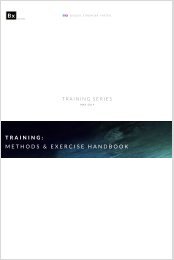Create successful ePaper yourself
Turn your PDF publications into a flip-book with our unique Google optimized e-Paper software.
HTKSPORT<br />
These methods are good because the motion is specific, however, returning to the<br />
earlier point about trading intensity for specificity, the resistance cannot be so great<br />
the either the mechanics themselves or the speed at which the mechanics are used is<br />
altered. Often if the load on the sled, for example, is too great then the motion<br />
changes to a slow drag as opposed to a sprint. While the same muscle groups may be<br />
being used, they are not being recruited in the same way and are performing very<br />
different biomechanic tasks – pulling vs. propulsion are very different motor patterns.<br />
Heavy sled dragging may be a useful tool to train general strength or could be used<br />
as a neural priming exercise for a coupled speed exercise, but it has no direct carry<br />
over to sprinting speed. The same can be said about heavy squats, or just about any<br />
heavy load exercise – there is only a very small window of resistance where the<br />
specific movement can be overloaded before the movement is slowed or altered to a<br />
point where a different stimulus is being utilised. Similarly if the speed of the<br />
motion/mechanics is reduced, then, unless the intent to move at maximal speed is<br />
maintained, the exercise is not specifically training maximal speed. If the load is too<br />
heavy then the neuromuscular input switches to generating tension to move the load,<br />
rather maximal elastic power or velocity, which seeks to add residence to a maximal<br />
recruitment at maximal velocity in order to increase the level of recruitment –<br />
sustained tension is a different input to elastic power, explosiveness or speed.<br />
Special strength for speed athletes is discussed in more detail below in PART 4.<br />
This is obviously not the case if the specific goal movement is a squat, deadlift or<br />
some other movement that is easily replicated in the gym with high intensity.<br />
Generally the more complex the movement the harder it is to replicate in the gym.<br />
This highlights why functional training can mean a number of different things, and,<br />
generally, why functional training for complex movements (or sports that involve<br />
complex dynamic movements) is difficult. This is also why I think training for sports<br />
should incorporate both specific and general methods, so that the body can be<br />
consistently exposed to specificity and intensity.<br />
09<br />
JUNE 2018 | ISSUE 01




